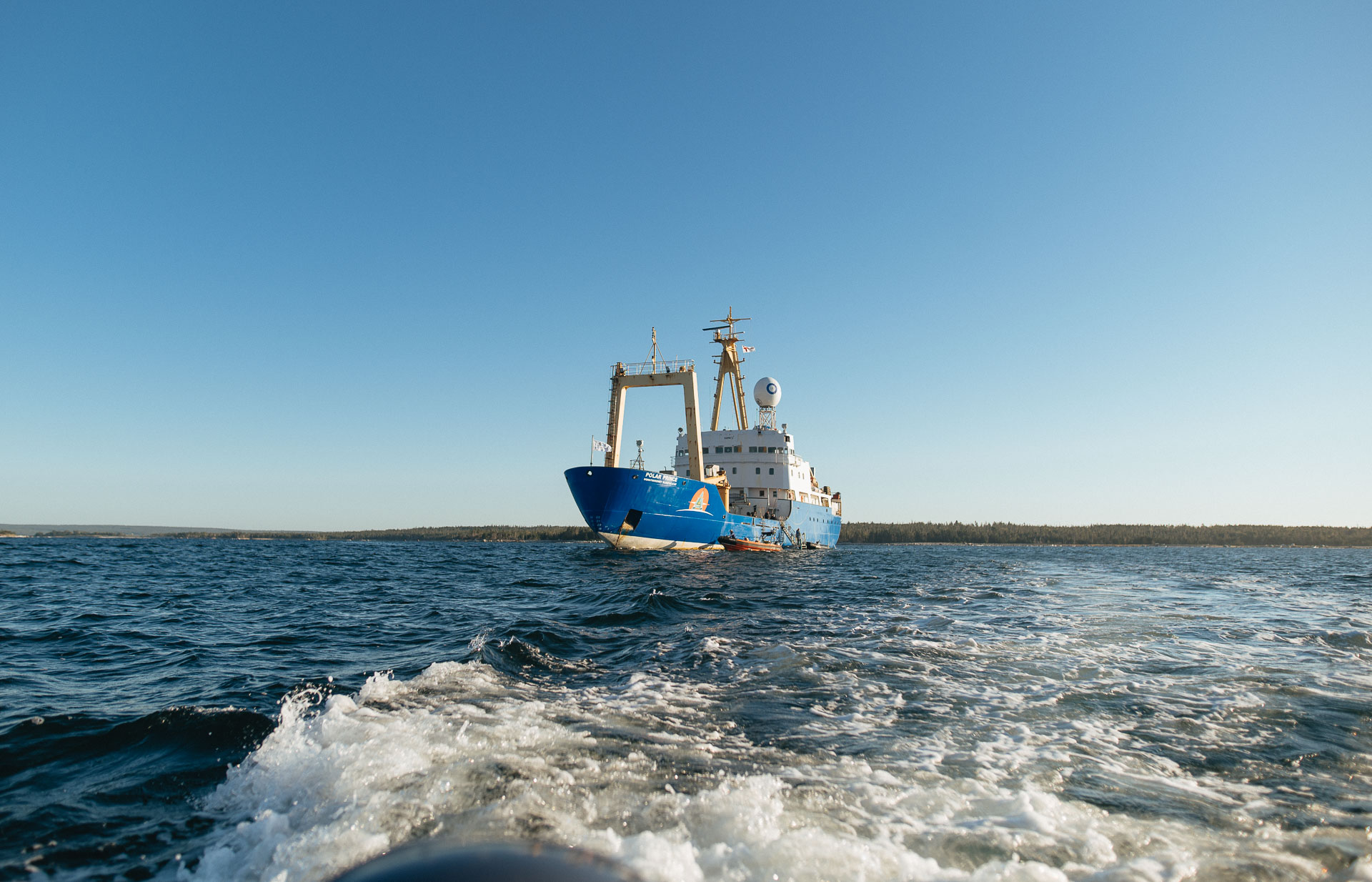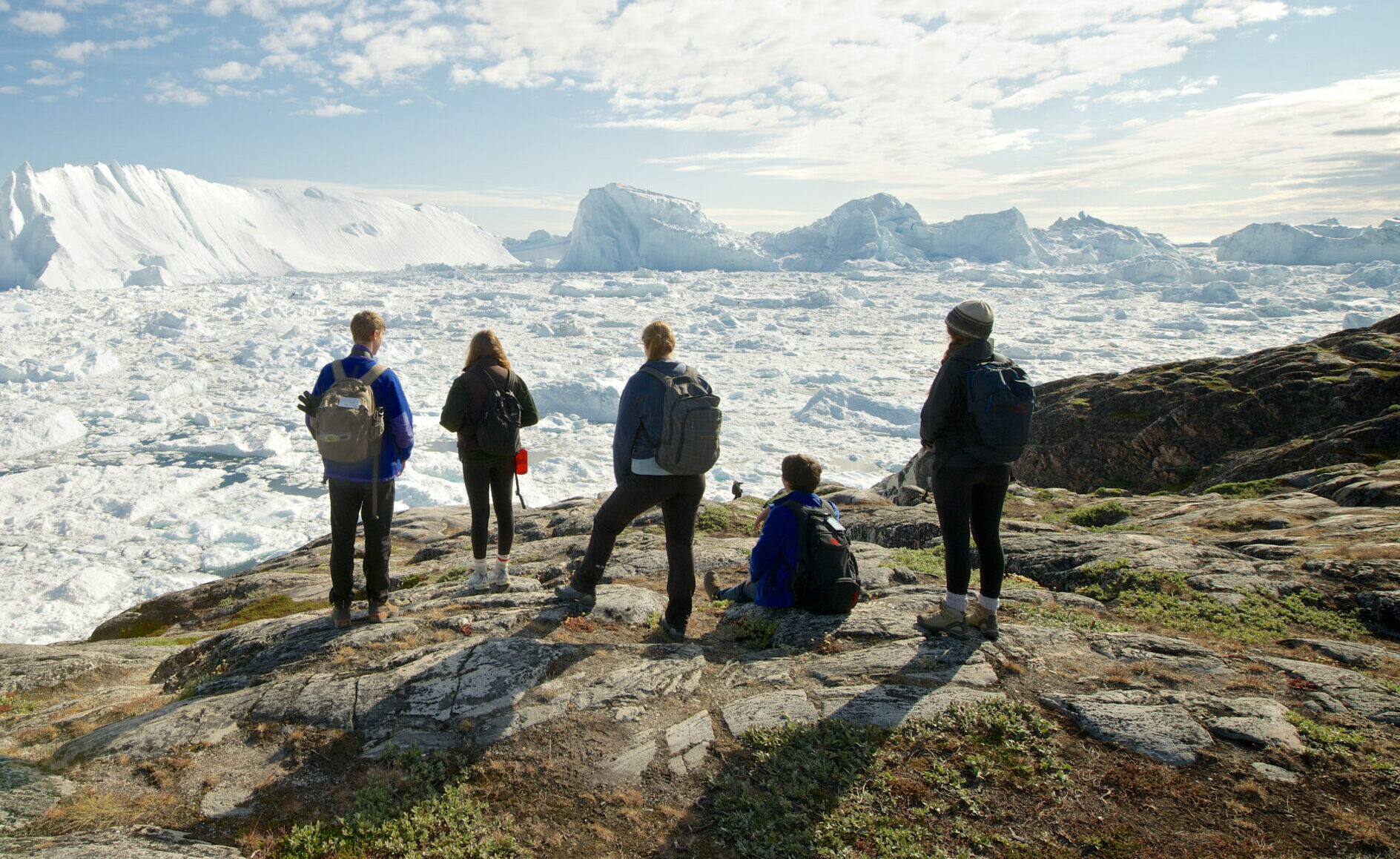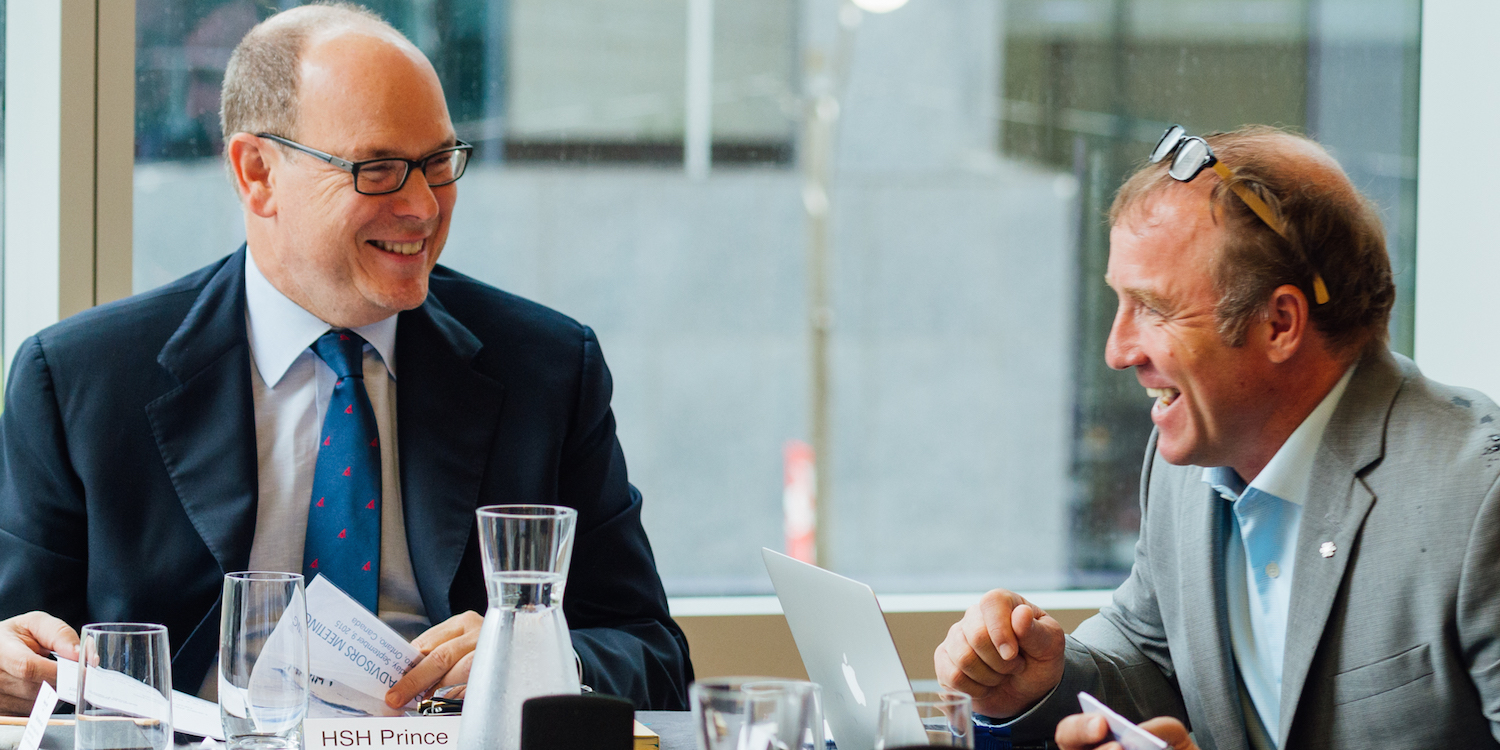2024 Blue Futures Pathways Expedition: Full Recap
One by one, participants, educators, and staff made their way through the Polar Prince’s maze of corridors to the ship’s hangar for a quick welcome aboard briefing. There, surrounded by a gallery of murals from past expeditions, the potential energy in the room became palpable. When the icebreaker’s engines roared to life and we began to move, the energy was released. We filed out of the hangar and gathered on the stern of the ship, soaking up the early August sun, snapping photos, and watching as the shapes and colours of Iqaluit began to blend into the surrounding tundra before disappearing altogether. The expedition had begun, and despite having an education-packed itinerary, there was no way of knowing what was really in store for us.
As we would soon learn, the 2024 Blue Futures Pathways expedition was as much a two-week immersive learning journey about the Sustainable Blue Economy set against the backdrop of the Labrador and Newfoundland coast, as it was an exploration of ourselves and our relationship to the blue world around us.

At its core, the BFP program, an endorsed action of the United Nations Ocean Decade, connects young people with education, employment, and funding opportunities to inspire and support them in developing successful careers in the Sustainable Blue Economy. For many of the 20 participants aboard, it made sense that such an undertaking was happening on a ship, not just because it allowed for visits to ecological reserves, national parks, and a medley of coastal communities but also because of the setting itself.
“I think what’s so great about the ship is that compared to an environment like a classroom where you go home at the end of the day… we’re always in this environment, this learning environment, and you can really feel everyone and their level of excitement for learning these things,” said Grace, from Vancouver, British Columbia, who, like many participants, had never been on a ship like the Polar Prince before.
One of the significant differences between this Blue Futures Pathways expedition and the other Students on Ice (SOI) expeditions is the age range, which spans 18-year-olds to those in their thirties. Because of this, the experience levels vary drastically; some participants recently graduated high school while others are doing their master’s degrees. Regardless of skill level or experience, it became apparent everyone had something to offer.
“To me, it’s been super special to see people around my age range that are already so knowledgeable and so willing to share. It’s quite inspiring,”
– Marikah, Rankin Inlet, Nunavut.

Another prevailing trait amongst the participants and roughly 20 educators and staff was a deep-seated curiosity and a willingness to listen and learn. “I’m hoping to learn more about the marine environment,” said Dominica from Sanirajak, Nunavut, one of ten participants also involved in a Qikiqtaaluk Corporation fisheries training program, a partner on this expedition. The third trait shared by all aboard was a love for the planet we call home. “I think the reason why we came all together is because we all have the same mindset of trying to protect Mother Earth,” said Dolcy, who joined the expedition from Kitigan Zibi Anishinabeg First Nation. As we would learn, that mindset is also needed for a sustainable economy.
But what is the Sustainable Blue Economy?
“I like to think of it as the green economy is related to land, the sustainable blue economy is related to the social, cultural, environmental and economic use of the ocean, but also of our ice, our rivers, our lakes, and also even how we manage wastewater and stormwater,” said BFP expedition leader Tara Mascarenhas.
Considering 71% of the earth’s surface is water, the sheer number of jobs and careers that could fall under this umbrella is mind-boggling. For the sake of the expedition, focus was given to five key themes: storytelling and communications, science methodology, ocean technology, drone piloting, and seafaring skills.
As participants learned, despite being separate themes, there was often overlap between any number of them for any specific task. Understanding what was going on at a given location and depth in the ocean required using a specific piece of technology that measures conductivity (salinity), temperature and depth. Monitoring for marine mammals or underwater noise levels requires a hydrophone. Trying to find out what lives in a given area by sampling water and eDNA also requires its own specific technology and tools. Getting to the physical location needed to do any of that work likely involves marine transportation, be it a ship or zodiac. To convey what you found in any of those endeavours requires some form of storytelling or communication.

But it isn’t just the themes that work together to complete a project or task; it’s those doing the work as well. As participants learned time and time again, collaboration and collective intelligence is key.
This was perhaps most evident during one of many excessively windy days we experienced off the coast of northern Nunatsiavut that left us ship-bound. The challenge that day was to find a suitable place to anchor overnight. As the groups cycled through the ship’s bridge and got the rundown on what to look for from the educators, they all picked the same location: a small, sheltered area between an island and the mainland. The location was so ideal that the captain, who had previously chosen another location, decided to drop anchor within a mile of it.
“All together in this room and on this ship, we have the collective intelligence to arrive at the same conclusion as people that are years and years more experienced than us at the thing that we’re doing. I think that was so cool,”
– Genevieve Gay, educator and Zodiac driver, Whitehorse, Yukon.
Just as there are many different careers related to the sustainable blue economy, there’s an even greater number of pathways to get there, with some far less direct than others but no less valid.
In some ways, the weather delays and challenges we experienced throughout the trip served as an example of non-traditional pathways that require flexibility, whether on an expedition or in life.
“A lot of the success you see around you doesn’t happen overnight. It happens with a lot of struggles, it happens with a lot of turmoil and changes in plans but people find what they want,”
– Safe, St. John, New Brunswick.
Not everything we learned on the expedition was about careers or building new skills. Even before boarding the ship, we had the opportunity to begin to change how we see things.

On our first grey, drizzly day in Iqaluit, we hiked along the shoreline, and as we did, Paul Sokoloff, our expedition logistics coordinator and resident botanist, gave us a scientific rundown of the varied plant life we were seeing. The following day, we found ourselves back on the Nuna, “land” in Inuktitut, this time with Zipporah Ungalaq, an Iqaluit resident who is part of an Arctic Inspiration Prize-winning team helping tackle food security in the territory. Much like the day before, we strolled across the green tundra under grey skies and drizzle, except this time, we learned the plant’s traditional names and uses.
“We’re learning that knowledge comes in many different forms, and all are important in a sustainable blue economy,”
– Sydney, Norris Point, Newfoundland.
While it wouldn’t be formally introduced until later in the trip, this way of understanding things through the strengths of Western and Indigenous knowledge systems for the benefit of all is called the Two-Eyed seeing approach, or Etuaptmumk in Mi’kmaq.
Shortly before joining the expedition, Educator Chris White had a chance to meet and talk with Mi’kmaw Elder Albert Marshall, who coined the term alongside his late wife, Murdena Marshall, and biology professor Cheryl Bartlett. “He talked about how science, while powerful, has been mainly a tool of destruction most of our history,” said Chris during a workshop on two-eyed seeing during the expedition. “He talked about how we need a balance of mind, soul, heart, and body. Everything we do should revolve around love, compassion, and respect.” In other words, the blue economy can’t just be environmentally and economically sustainable; it must also be socially sustainable.
But two-eyed seeing isn’t a noun; it’s a verb, and being socially sustainable requires constant action. As an engineer by trade and a volunteer with the Nova Scotia Environmental Network, Chris has noticed that while most settler-led groups have lots of room to improve, many Indigenous-led groups are doing two-eyed seeing quite well.

During our stop in Nain, the administrative capital of Nunatsiavut, we had a chance to visit SmartICE, a social enterprise that has found a way to blend both science and Inuit knowledge into a set of tools that are beneficial to communities across the North. There, educator Rob Briggs, who was involved in developing SmartICE’s initial tool, discussed how a changing climate led to unpredictable sea ice conditions along the Labrador coast and how bad the issue became in 2012. “One and a half of you would have gone through the ice in that season, and one in four people were uncomfortable to travel on ice,” said Rob. “I want you to just change your southern mentality. So that means you would be uncomfortable for six months of the year…driving in your car on the road, and one and a half of you would be in a significant accident that would require a search and rescue.”
The result was SmartICE and the suite of tools they’d go on to develop. Today, SmartBUOYs, which remotely measure ice thickness in a single location and SmartQAMUTIQs, which are pulled behind a snowmobile to measure ice thickness along a path, can be found in more than 30 communities across the North. Not only do these tools help communities with ice travel safety, but they also provide local jobs. Since 2018, SmartICE has trained 180 operators in most of the communities these expedition participants are from, another potential career path in the sustainable blue economy.
As the Oqwatnukewey Eleke’wi’ji’jit, Polar Prince in Mi’kmaq, slowly inched through its home waters of Newfoundland, the weather that plagued us at the start of the journey had returned. As it had throughout our trip, the extra ship time allowed for more workshops, jam sessions, beading, and even salsa dancing. With only a few days left in the expedition it also gave us time to begin processing everything we had seen, heard and, most importantly, felt.

Now anchored outside Bonavista, Newfoundland, a late afternoon sun beamed over our floating home. DJ Watsko, an expedition participant from Grise Fiord, Nunavut, perched on part of the ship’s elevated bow staring into the waters below. Despite several frigid swims in Iqaluit, Nachvak Fiord, and Nain, this time was different. His hesitation had nothing to do with the water, the warmest of the trip, but rather the roughly 20-foot jump needed to reach it. A moment later, and with a single determined movement, he was gone, soaring through the air and splashing into the waters below, surrounded by the nearby bobbing heads of the rest of the expedition participants.
That night, we all gathered in the hangar for the last time to reflect on the previous two weeks of the expedition.
“I learned a lot about who I am, who I am not,” said DJ. “Part of that was being scared, and then for a moment, you stop thinking, and you jump.”
His words resonated with so many in the room because everyone constantly took their own jumps throughout the expedition, whether getting on a ship for the first time, building an ROV, or speaking in front of a group. As we went around the circle, it was clear we had all grown; our next challenge would be continuing on this pathway.

“Sometimes it’s chance. Sometimes it’s a leap of faith, sometimes it’s a leap off the ship, but just have faith in yourself, trust yourself, and go forward with confidence,” said Tara. “This was all about showing you that there are opportunities out there… you just need to take them.”
As important as all the new skills, knowledge, and experiences were to everyone, it was also the people in that room and the collective energy they brought, that were unanimously a highlight of the expedition and one that would continue long after we disembarked in St. John’s.
“As I look at everyone around us, I’m just in a sea of inspiration,” said Safe, a participant from Saint John, NB. “Everyone comes from different backgrounds, different cultures, different parts of Canada, different ages, different jobs, small communities, big communities…and it has really opened my mind to what is possible. I really feel like now I could live anywhere, I can do anything, and I can accomplish a lot of great things.”





